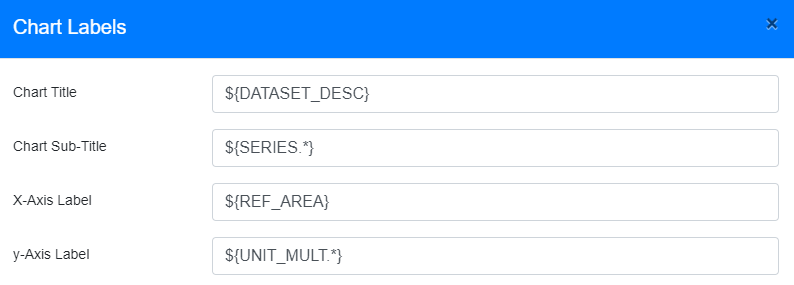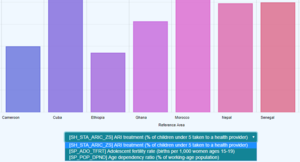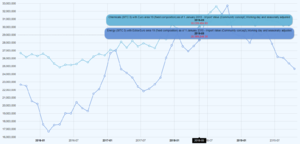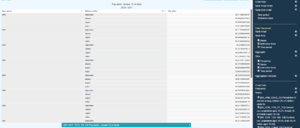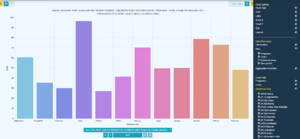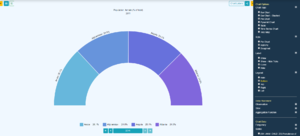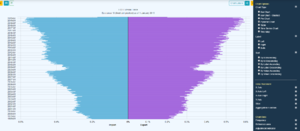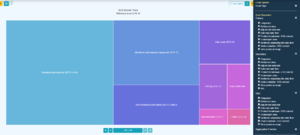Charts
Contents
Overview
These features are no longer available in Fusion Registry V11 and subsequent versions.
The Fusion Data Browser offers charting and tabulation capabilites to visulaise the series selected from the Series List page. There are three main categories of visualisations:
- Time Series Chart - Providing a view of series values over time
- Tabulation of Data - Providing a view of all series in a pivot table
- Cross Sectional Charts - Providing a view of a data sliced for a single time period and aggregated for one or more dimensions (example charts: Bar/Pie/Treemap/Pyramid)
Charts can be given dynamic lables which update as the data being charted changes, static lables, or a mixture of the two. Charts can also be saved locally, or shared as URL or embedded link.
General chart configuration is part of the Data Browser set up.
Dynamic Labels
Dynamic Labels enable values to be picked from the metadata for the dataset, HTML markup can be used, as well as a mix of static content with the dynamic content.
The syntax places varaibles within the ${...} characters, where the ... is replaced with the ID of the Component, for example ${FREQ} would output the word 'Frequency' if the Concept FREQ had the label Frequency. ${FREQ.*} outputs the reported value for Frequency which could result in the Label 'Annual' if the data being displayed is reported against the Annual Frequency Code. the .* is used to indicate 'all code lables for component' so, if there are multiple values reported it will be displayed in a comma separated list, for example ${REF_AREA.*} could result in France, Germany, Poland if the data bring graphed is for three countries.
${T} is replaced with the Time Period or Range, if the chart is being displayed for a single time period, ${T} would be replaced with that time period '2015-Q1' for example. If the data is for a number of time periods, the ${T} is replaced by the range in the syntax 'start period / end period' for example '2015-Q1 / 2019-Q4'.
Slicing Dimensions
All Charts types support Slicing data, this is putting one or more Dimensions into a Cross Sectional Slice. For example if a Dataset contains Unemployment figures for Countries: United Kingdom, France and Germany the Country Dimension could be placed into the Slice, meaning the countries are put into a drop down control at the bottom of the chart, enabling the user to quickly swtich the chart data for another of the countries. If Dynamic labels are used, the lables will update automatically as the Slice selection is changed.
Slicing Time
When Time is sliced, the control is not a drop down, but a time picker, which enables quick access to the start and end periods, and previous/next periods of time.
The time slice shows the current period, which is an editable control, by clicking on the time period it can be modified by simply typing in a new period to view. The time format can be typed in using any of the SDMX Time Period formats. The format used does not need to match the frequency of the dataset, for example if the data is quarterly and 2001 is typed in, the time will resolve to 2001-Q1. If a time period is entered which has no data, the closest period with data will be used, for example typing in 2001-05-12 may result in 2001-Q2 as this is the closest period to the choosen date.
For Cross Sectional Charts (Bar / Pie) the Time Dimension is automatically put into the Slice at the bottom of the chart.
Time Series Chart
The Time Series Chart provides a view of series over time. All reported time periods are resolved to an absolute point in time, at the beginning of the period, for example an observation against the Annual period 2015 would resolve to 2015-01-01, which would be the same resolution as 2015-Q1 and 2015-01.
Regardless of the periods the data was reported against, the Time Series chart displays time in the X-Axis using the following syntax (note the date as it was reported can be displayed in the roll over bullet, this can be set up in the chart configuration)
- Annual - YYYY or MMM-YYYY (example Nov-2015)
- Monthly - YYYY-MM (example 2009-04)
- Daily - YYYY-MM-DD (example 2008-09-09)
For series with many thousands of data points, the time series chart can start to look messy and render slowly, however a group count can be applied to smooth out the line. Group count only plotting a subset of the data points, and when the chart is zoomed in to a smaller time period, it is re-renders to include more data points. The group count is defined in the chart configuration.
Time Series Specific Options
- Chart Type : Line Chart or Area Chart
- Add Scroll bars on both the X and Y axis
- Labels for X and Y Axis
- Legend Labels
- Override Bullet Labels
Pivot Table
The Pivot Table provides a tabulation visulisation where the Dimension placement can be set to be part of the Header or Rows, and the order of each Dimension can be set. Like all other charts, a Dimension can be placed into the Slice, Dimensions can also be removed from the Chart data and Aggregated accroding to the choosen aggregation function.
Bar Chart
Pie Chart
The Pie Chart Slices over time, and aggregates the remaning data to a single Dimension. The aggregation function can be selected, with sum used as the default.
The Pie chart has 3 variants, Pie, Doughnut, and Half Pie. Also supported are labels on the chart, which can be curved around the circumference of the chart.
A Legend can be added to the chart. The Legend is interactive, allowing Pie segments to be removed from the chart or added back in on click.
Pyramid Chart
The pyramid chart, typically used to display information such as population by Sex and Age, enables one Dimension to be plotted against 2 values for one of the other Dimensions.
The X-Axis is measured as a percentage, where 100% is the sum of all the observaitons for the value being plotted, for example if Imports were plotte against Exports, each Import value is a % of total imports in the chart, and each export value is a % of total exports in the chart. The actual reported value can be viewed when hovering the cursor over the bar.
